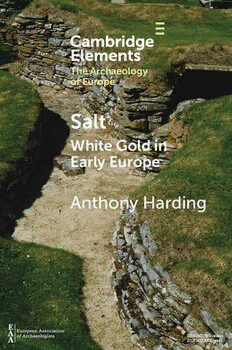
Salt: White Gold in Early Europe PDF
Preview Salt: White Gold in Early Europe
H This Element provides a concise account of the archaeology a r of salt production in ancient Europe. It describes what salt is, d i where it is found, what it is used for, and its importance for n g human and animal health. The different periods of the past in which it was produced are described, from earliest times down to the medieval period. Attention is paid to the abundant The archaeology literary sources that inform us about salt in the Greek and of Europe Roman world, as well as the likely locations of production in the Mediterranean and beyond. The economic and social importance of salt in human societies means that salt has served as a crucial aspect of trade and exchange over the centuries, and potentially as a means of individuals and societies S Salt achieving wealth and status. a lt White gold in Early Europe about the Series Series Editors Elements in the Archaeology of Europe Manuel Fernández- is a collaborative publishing venture Götz between Cambridge University Press University of Anthony Harding and the European Association of Edinburgh Archaeologists. Composed of concise, Bettina Arnold authoritative, and peer-reviewed studies University of by leading scholars, each volume in this Wisconsin– series will provide timely, accurate, and Milwaukee accessible information about the latest research into the archaeology of Europe from the Paleolithic era onwards, as well as on heritage preservation. Cover image: A house at Skara Brae. ian35mm / Getty Images ISSN 2632-7058 (online) ISSN 2632-704X (print) ElementsintheArchaeologyofEurope editedby ManuelFernández-Götz UniversityofEdinburgh BettinaArnold UniversityofWisconsin–Milwaukee SALT White Gold in Early Europe Anthony Harding University of Exeter UniversityPrintingHouse,CambridgeCB28BS,UnitedKingdom OneLibertyPlaza,20thFloor,NewYork,NY10006,USA 477WilliamstownRoad,PortMelbourne,VIC3207,Australia 314–321,3rdFloor,Plot3,SplendorForum,JasolaDistrictCentre, NewDelhi–110025,India 103PenangRoad,#05–06/07,VisioncrestCommercial,Singapore238467 CambridgeUniversityPressispartoftheUniversityofCambridge. ItfurtherstheUniversity’smissionbydisseminatingknowledgeinthepursuitof education,learning,andresearchatthehighestinternationallevelsofexcellence. www.cambridge.org Informationonthistitle:www.cambridge.org/9781009017640 DOI:10.1017/9781009038973 ©AnthonyHarding2021 Thispublicationisincopyright.Subjecttostatutoryexception andtotheprovisionsofrelevantcollectivelicensingagreements, noreproductionofanypartmaytakeplacewithoutthewritten permissionofCambridgeUniversityPress. Firstpublished2021 AcataloguerecordforthispublicationisavailablefromtheBritishLibrary. ISBN978-1-009-01764-0Paperback ISSN2632-7058(online) ISSN2632-704X(print) CambridgeUniversityPresshasnoresponsibilityforthepersistenceoraccuracyof URLsforexternalorthird-partyinternetwebsitesreferredtointhispublication anddoesnotguaranteethatanycontentonsuchwebsitesis,orwillremain, accurateorappropriate. Salt WhiteGoldinEarlyEurope ElementsintheArchaeologyofEurope DOI:10.1017/9781009038973 Firstpublishedonline:July2021 AnthonyHarding UniversityofExeter Authorforcorrespondence:AnthonyHarding,[email protected] Abstract:ThisElementprovidesaconciseaccountofthearchaeologyof saltproductioninancientEurope.Itdescribeswhatsaltis,whereitis found,whatitisusedfor,anditsimportanceforhumanandanimal health.Thedifferentperiodsofthepastinwhichitwasproducedare described,fromearliesttimesdowntothemedievalperiod.Attentionis paidtotheabundantliterarysourcesthatinformusaboutsaltinthe GreekandRomanworld,aswellasthelikelylocationsofproductionin theMediterraneanandbeyond.Theeconomicandsocialimportance ofsaltinhumansocietiesmeansthatsalthasservedasacrucialaspect oftradeandexchangeoverthecenturies,andpotentiallyasameansof individualsandsocietiesachievingwealthandstatus. Keywords:salt,ancientEurope,briquetage,solarevaporation,trough technique ©AnthonyHarding2021 ISBNs:9781009017640(PB),9781009038973(OC) ISSNs:2632-7058(online),2632-704X(print) Contents 1 Introduction 1 2 WhatSaltIs,WhereItOccursandHowItIsExploited 3 3 ProductionfromEarliestTimesdowntotheNeolithic 20 4 TheCopperandBronzeAges 26 5 FromIronAgetoRomaninNorthernEurope 36 6 GreekandRomanSaltintheMediterranean 54 7 SaltasanEconomicandSocialMover 66 8 Conclusion 72 Bibliography 74 Salt 1 1Introduction Salt,sodiumchloride,issuchacommonsubstanceinourlivesthatwetendto takeitforgranted.Atriptothesupermarketallowsustochoosebetweenseveral different sorts – sea salt, rock salt, cooking salt (with added iodine); factory- processed salt, artisanal salt; home-produced salt, salt imported from the other sideoftheglobe.Mostofthetimewepaynoattentiontoit,nordowethinkabout whereitcomesfrom.Itisjustthereinourlives.Butitwasnotalwaysthus. Someancientauthorswroteaboutsalt,buttheygenerallytelluslessthanwe wouldliketoknowaboutwheresaltcamefromandhowitwasproduced.This suggeststhatforthemtooitwassuchacommoncommoditythattheydidnot think it worth going into details. Medieval and Renaissance writers are more forthcoming,notablyGeorgiusAgricola,writinginthesixteenthcentury;from them it is possible to infer much of what went before them. In fact, the productionofsaltwasamajorconcernatallperiodsofthepast,includingthe ancient past. In this Element, I shall describe what we know of the European productionofsaltfromearliesttimesdowntotheRomanperiod. TheImportanceofSalt Humansandanimalsallneedtoconsumesaltinordertogetanintakeofsodium, whichregulatesthefluidbalanceofthebodyandassistswithotherfunctionsofthe internalorgans.Thefactthatformanypeoplesaltadds‘savour’tofood,inother wordsitmakesblandfoodtastemoreinteresting,isperhapsafortunatestimulusto its consumption, if not a biological adaptation. How much salt is necessary for healthisamatterofsomedebate:thefigureof6gdaily(2.4gofsodium)isoften quoted as the ideal maximum (it is the amount recommended by the NHS in Britain, for instance); larger amountsare believed to increase the risks for high blood pressure, cardiovascular disease and other problems. Eating too little salt alsocausesproblems,thoughinfactmosthumansgetenoughsaltthroughtheir normaldiet,especiallyiftheyeatmeat,eggsorfish.Animalswillseekoutsaltif notgivenitaspartoftheirdiet.Experimentalworkinthe1960sand70sshowed howanimalsdeprivedofsaltsufferilleffectsthatleadtopoorhealth;sodiumis neededespeciallyfornursingyounganimals.This‘hungerforsalt’(Denton1984) makesanimalsseekoutsaltypoolsorrockstolick,andtoeatvegetationthatisrich insodium. Salt is also crucial for other reasons, the most significant in pre-industrial societiesbeingthepreservationoffood.Itsantibacterialpropertiesmakeitideal for this purpose, as well as for combating infection from wounds and sores. In peasant communities it is used to this day to treat health problems such as rheumatism and arthritis. Today, however, in most of the world the uses of salt 2 TheArchaeologyofEurope asafoodstuffandpreservativearedwarfedbythoseofindustryandroad-saltingin winter,whichdonotapplytotimesbeforetheIndustrialRevolution. SaltintheWorld Saltisfoundcommonlyintheworld.ThelargestdepositsareintheAmericas, Saharan Africa and parts of Asia (China and the Himalayan area); the largest producerstodayareChina,theUnitedStatesandIndia.InEurope,thelargest producerisGermany,butseveralothercountrieshavesignificantsaltresources, notably Spain, Poland, Romania and the UK (salt is one of the few natural resourcesinwhichBritainisself-sufficient). MuchhasbeenwrittenabouthistoricalsaltexploitationinNorthAmericaand in China, while ethnographic accounts have covered Niger (Gouletquer 1975; Gouletquer & Kleinmann 1984), New Guinea (Godelier 1969; Pétrequin et al. 2000)andseveralMesoamericancountries(Good1995;Williams1999).Several booksandwebsitesgiveexcellentdescriptionsandimagesofnon-industrialsalt Figure1BlocksofTaoudennisaltattheportofMoptiinMali,Africa (informationinaccompanyingtextandthisimage‘Moptisel’byTaguelmoust downloadedattheFrenchlanguageWikipedia.LicensedunderCCBY-SA3.0 viaWikimediaCommons-http://commons.wikimedia.org/wiki/File:Mopti_sel .jpg#/media/File:Mopti_sel.jpg). Salt 3 production, for instance in Mali (Figure 1) (www.saltworkconsultants.com /ancient-salt-trade-and-its-value/,lastaccessed14December2020). Inthisvolumemyaimistoprovideashortaccountofsaltproductioninthe ancientworld,concentratingonEuropefromearliesttimesdowntotheRoman period.GoodaccountsofsaltinpartsoftheAmericasarethosebyIanBrown, Heather McKillop and Dumas & Eubanks (Brown 1981; McKillop 2002; Dumas & Eubanks 2021), while for China the best accounts in English are thosebyToraYoshidaandRowanFlad(Yoshida1993;Flad2011).ForAfrica theaccountsbyPaulLovejoy(1986)andAnnMcDougall’smanycontributions are important; there is a useful web article by Mark Cartwright on the west Africansalttrade(www.ancient.eu/article/1342/the-salt-trade-of-ancient-west- africa/,lastaccessed10November2020).1 There are several histories of salt production and consumption (e.g. Mollat 1968; Multhauf 1978; Bergier 1982; Adshead 1992; Kurlansky 2002) and several important books by the historian Jean-Claude Hocquet (e.g. Hocquet 1978–9;2001;2019).His2001bookisanexcellentintroductiontothetheme, withmarvellousphotographsofsaltproductioninmanypartsoftheworld. ThestoryinEuropegoesbackmillennia,andintechnologicaltermsisvaried and often complex. In the sections that follow I shall look at these matters in detail. 2WhatSaltIs,WhereItOccursandHowItIsExploited Sodium chloride, common salt, is an evaporite mineral, that is, one that is concentrated or crystallised from an aqueous solution, either the oceans, or lakessuchastheDeadSeaortheGreatSaltLakeinUtah.Throughevaporation, over geological timescales, rock salt (halite) is created. Salt in rock form is foundintheformofdiapirs,dome-likestructuresarisingfromancientseawater deposits,protrudingupwardsandsometimesappearingontheearth’ssurface. In mountainous areas, these domes have been subjected to various tectonic processesthathaveresultedinthembeinguplifted,sothatthesaltrockappears atornearthesurface.Thepresenceofundergrounddiapirsisalsoresponsible fortheemergenceofsalt-waterspringsthatemergeintothelightofdaywithout anyrocksaltbeingapparent,asrainwaterandotherundergroundwaterisforced upwards. Saltisfoundwidelyintheworld.InthisElement,Iamconcernedprincipally withEurope,wheresaltoccursinmanyareas(Figure2).Thelargestareaisthat spreading across the north of the continent, from northern England through GermanyandPoland,buttherearemanyotherareasthatarerichindeposits, 1 Theseareonlyafewofthemanybooksandarticlesonsaltindifferentpartsoftheworld. 4 TheArchaeologyofEurope Figure2MapofEuropeshowingthemajorsaltareasandtheirgeologicalage. Source:Harding2014. notablytheCarpathianarea,wherethe‘foredeep’extendsfromsouthernPoland through western Ukraine, touching on northern Romania. Another area with many salt deposits occurs in the Alps, particularly in Austria; also in France, Spain,Turkeyandelsewhere.Ofcourseconcentratingonrocksaltandinland salt-waterspringsignorestheothermainsourceofsalt:thesea.Thesaltcontent ofseawateristypicallyaround3.5percent(i.e.35gofsaltin1litreofwater); extractingitthroughevaporationiscrucialforcoastalcommunities,inthepast asnowadays.Saltlakescancontainmuchmoresalt:theDeadSea,forinstance,
